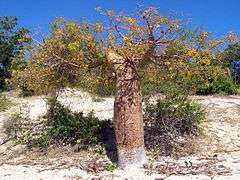Adansonia rubrostipa
Adansonia rubrostipa, commonly known as fony baobab, is a deciduous tree in the Malvaceae family, previously included in Bombacaceae, a family no longer recognized. Of eight species of baobab identified to date, six are indigenous to Madagascar, including fony baobab. It is endemic to western Madagascar, found from Parc Nationale Baie de Baly, south.[1] It is associated with well-drained soils and is found in dry and spiny forests.[1] It occurs in the following protected areas: Amoron'i Onilahy, Baie de Baly, Menabe Antimena, Mikea, Namoroka, Ranobe PK 32, Tsimanampesotse, Tsimembo Manambolomaty, Tsinjoriake (La Table/St Augustin).[1]
| Fony baobab | |
|---|---|
 | |
| A. rubrostipa in the Anjajavy Forest | |
| Scientific classification | |
| Kingdom: | Plantae |
| Clade: | Tracheophytes |
| Clade: | Angiosperms |
| Clade: | Eudicots |
| Clade: | Rosids |
| Order: | Malvales |
| Family: | Malvaceae |
| Genus: | Adansonia |
| Species: | A. rubrostipa |
| Binomial name | |
| Adansonia rubrostipa | |
Fony baobab is the smallest of the baobabs, easily identified by its distinctive reddish bark. It is usually bottle-shaped and has toothed leaves and round fruit.[2]
References
- Letsara, R., Faranirina, L., Razafindrahaja, V. & Faramalala, M. 2019. Adansonia rubrostipa. The IUCN Red List of Threatened Species 2019: e.T37679A64366919. https://dx.doi.org/10.2305/IUCN.UK.2019-3.RLTS.T37679A64366919.en. Downloaded on 08 July 2020
- Behrens, K. and K. Barnes. 2016. Wildlife of Madagascar. Wild guides, Princeton University Press.
